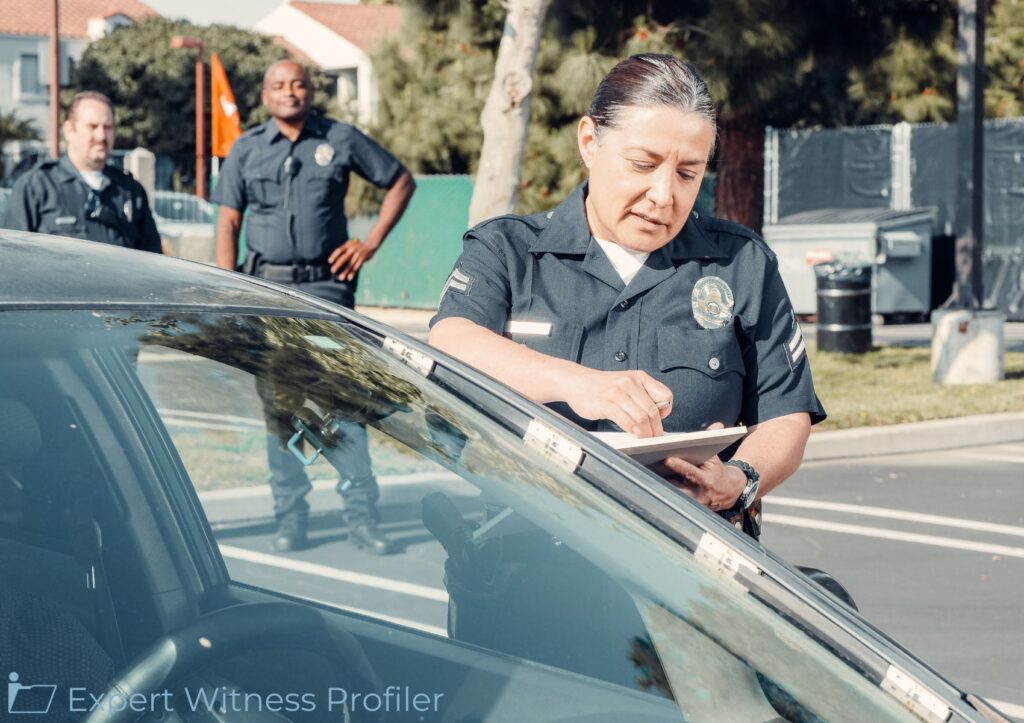Biomechanics Expert’s Testimony on Law Enforcement Tactics Excluded
Posted on October 9, 2025 by Expert Witness Profiler
Plaintiffs alleged that Defendants former Washington County Sheriff’s Office (“WCSO”) Deputy Defendant Jeffrey Aaron Edwards (“Edwards” or “Deputy Edwards”) and former WCSO Deputy Brian Mizelle (“Mizelle” or “Deputy Mizelle”) used excessive force against them during a March 2, 2022, attempt to transport Plaintiff Gary Thomas (“Thomas”) to the Washington County Courthouse. The factual circumstances in this case primarily surround the transportation of Plaintiff Thomas from a patrol vehicle to the Washington County Courthouse and Plaintiff Mary Moore’s aggressively lunging at Edwards during that attempt, which caused her to be properly struck by Edwards.
Thomas was placed under arrest by Deputy Edwards and was being transported inside the courthouse with the assistance of Deputy Mizelle when Moore interfered with Thomas’ arrest. Thomas became injured while he resisted arrest requiring Edwards and Mizelle to use force to maintain safety and control of this incident.
Defendants Edwards, Barnes, and Mizelle offered the testimony of Albert Vangura to opine on the biomechanics of the interactions between Edwards and Plaintiffs, the cause of Plaintiffs’ injuries, and the position of Edwards’s hand when he struck Moore.
Plaintiffs filed a motion in limine to exclude the testimony of Vangura.

Biomechanics Expert Witness
Albert Vangura is an engineering professional with nearly forty years of experience in biomechanical and human factors evaluations, product design and development, manufacturing, and testing.
He holds a Master of Science Degree in Bioengineering from the University of Pittsburgh, a Bachelor of Science Degree in Exercise and Sports Science, and an Associate of Science Degree in Mechanical Engineering Technology, both from The Pennsylvania State University.
Discussion by the Court
Reliability
In their motion in limine to exclude Vangura’s opinions and testimony, the Plaintiffs argued that Vangura’s report and opinion lacked any reliable or
recognized methodology; therefore, the Court should exclude them.
The Court found that Vangura’s testimony lacked reliability. Vangura did not identify methods or principles underlying his ”bioengineering and biomechanical engineering investigation and analyses.” In fact, when asked about his methodology, Vangura responded that he used the ASTM E620-18. The ASTM E620-18 is not a methodology. It is three pages of standards about forensic or technical reports an expert can use in any field. In other words, it tells the expert how to write their report, not the methodology the expert should follow.
Moreover, Vangura used one of the cited sources in his report, and he misapplied it. Specifically, Vangura cited Accidental Injury, a book that “looks at the applied biomechanics of accidental injuries.” Vangura used findings from Accidental Injury to analyze Moore’s facial injuries. It is undisputed that Defendant Edwards struck Moore in the face intentionally; thus, “observations from accidental injuries” are irrelevant and inapplicable. This fact undermined the reliability of Vangura’s report.
Biomechanics experts frequently address causation issues, but experts addressing causation must demonstrate how and why they eliminated other causes when reaching their conclusions. Vangura never mentions if or how he eliminated other causes when he opines on proximate cause.
Relevance
Plaintiffs argued that Vangura’s testimony consisted of common sense observations. Vangura spent most of his report narrating and characterizing the video evidence, which requires no specialized knowledge and is within the function of the jury. Beyond the video narration, Vangura’s discussion and findings included opinions and testimony about the biomechanics of walking. Vangura admitted that he made findings by simply ”watching this video,” a factfinding exercise that is well within the jury’s function.
The Court found that these findings “risk ‘supplanting a jury’s independent exercise of common sense’ and its role of determining the facts.”
Qualification
Plaintiffs argue that Vangura is not qualified to opine about law
enforcement tactics and practices or the parties’ injuries and medical conditions. Vangura has an associate’s degree in mechanical engineering technology, a bachelor’s in exercise and sports science, and a master’s in bioengineering but no medical degree. Moreover, Vangura is not qualified to speak on proximate cause because his testimony rests on opinions about law enforcement tactics and practices.
The Court found that Vangura’s testimony about the proximate cause of injuries in products liability cases does not qualify him to testify to proximate cause in an excessive force case, especially when his testimony goes beyond the purview of biomechanics and leads to hypotheticals about the necessity of arrests and an officer’s use of force.
The Court also found that Vangura’s report consisted of improper opinions on the parties’ injuries. The parties agreed that biomechanical experts cannot make independent medical diagnoses or offer opinions about the specific causes of an injury.
Lastly, the Court found that Vangura is not qualified to opine about whether Thomas was conscious after falling down the courthouse stairs despite consulting Thomas’s medical records. Vangura has not demonstrated that he has any knowledge, education, or training to (1) determine whether a person is conscious based on video evidence or (2) assess the relationship between loss of consciousness and a traumatic brain injury. Thus, Vangura is not qualified to opine on this topic.
Held
The Court granted the Plaintiffs’ motion in limine to exclude the testimony of Albert Vangura.
Key Takeaway:
Expert testimony may be admissible even though it does not rely on anything like a scientific method. But the expert must explain how his experience leads to the conclusion reached. why his experience is a sufficient basis for the opinion. and how his experience is reliably applied to the facts. Vangura failed to demonstrate how his experience as a biomechanics expert specializing in products liability and vehicle crashes led him to his conclusions, why that experience suffices to support his findings in an excessive force case, or how he applied that experience to the video evidence here.
Case Details:
| Case Caption: | Moore Et Al V. Barnes Et Al |
| Docket Number: | 2:23cv56 |
| Court Name: | United States District Court, North Carolina Eastern |
| Order Date: | September 30, 2025 |





